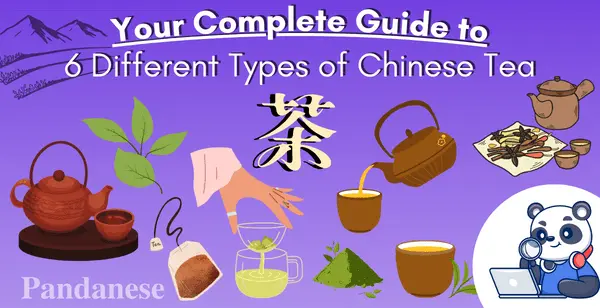
Your Complete Guide to Different Types of Chinese Tea
For several people, nothing beats a great cup of tea in the morning. Its pleasant, pure flavor instills a sense of peace and concentration. But maybe only a few of us know that this graceful beverage originates from China. Chinese tea has a long history from ancient times, keeps a central place in Chinese traditional culture, and attaches great importance to spiritual enjoyment and ethics.
As China is the hometown of tea, there are various types of Chinese tea. Each comes with a different level of fermentation and manufacturing. This article will walk you through the history of Chinese tea and introduce the most common types of this elegant beverage.
A brief history of Chinese tea
Tea has a history that extends back nearly 5,000 years to Chinese history. According to history, Emperor Shen Nung found tea in 2732 B.C. after seeing leaves from a wild plant dropped into a bowl of hot water.
He was instantly attracted to the delightful aroma of the emerging drink and tasted some of it. When sipping the drink, the emperor felt a warm sensation as if the drink was exploring every portion of his body. Shen Nung called the drink “ch’a,” a Chinese character that means “to check or investigate.”
In the following parts, let’s take a closer look into the most common types of Chinese tea and explore their significant differences and uniqueness.
Six common types of Chinese tea
1. 绿茶 (lǜ chá)—Green tea
One of the most common Chinese tea types, Chinese green tea is the most ancient and prominent form of tea, primarily consumed in China for thousands of years. Green tea is manufactured from the tea plant’s fresh shoots, and the ingredients are left to dry and prepared as per the flavored teas required.
Green tea contains the most antioxidants and inhibitors in comparison to other teas. The key is its processing: green tea is usually harvested and dried on the same day. This allows for minimum oxidation, preserving its natural deep green coloring, vitamin C, nutrients, and enzymes, among other things.
As a result, green tea is the perfect choice for a detoxifying and even dieting beverage.

The Chinese green tea
So, how does it taste?
Green tea has a sweet, mild, soft, and toasted flavor. It can also carry a nutty, flowery, or fruity taste, depending on where it is cultivated. However, one thing is sure: green tea tastes lighter than black or oolong tea due to its low oxidation level.
Here are some popular types of Chinese green tea:
Longjing Chun Mee (Dragon Well)
Bi Luo Chun green tea
Huangshan Maofeng tea
Lu’an Melon Seed
Gunpowder tea
2. 红茶 (hóng chá)—Black tea
One of the most common Chinese tea varieties, Black tea, also called red tea, is the second most popular Chinese tea type. This tea is harvested from the fresh, young branches of tea plants. The leaves then go through a variety of processing procedures. It is wilted, rolled, and crushed before being entirely oxidized. As a last phase in the process, the leaves are dried in an oven, preventing additional oxidation.
The final brew has a scarlet to dark brown color. Black tea usually smells beautiful and complicated, ranging from light and essential to malty and savory. While diverse plantation areas produce distinct varieties of black tea – malty, smokey, earthy, spicy, citrusy, sweet, and fruity – many black teas have something in common: they taste robust, powerful, and deep.

The Chinese black tea
Because of the extensive oxidation process, black tea feels heavier and darker than green or oolong tea.
One interesting note is black tea contains more caffeine than almost any other tea. Only pu-erh tea outperforms it because of the extended oxidation process.
An 8 oz (240 mL) portion of black tea provides 40-70 mg of caffeine, but the same amount of coffee delivers 95-200 milligrams. Yes, black tea contains less caffeine, but it’s still enough to disrupt your sleep pattern. So, avoid drinking black tea before bedtime! If you’re craving a cup of tea, try herbal tea or camomile tea instead.
Some common examples of black tea are the following:
Yunnan’s Dianhong black tea
Yichang black tea
Keemun black tea
Nanchong black tea
3. 白茶 (bái chá)—White tea
White tea is one of the rarest and most expensive since the leaves and buds of white tea are collected only once a year, at the beginning of spring. The farmers harvest young tea blossoms when the leaves are still firmly packed to make white tea.
White tea is the most minimally processed tea. The buds and leaves are simply dried, bringing a delicate, light golden color. The smell and flavor vary by area.
However, white tea typically smells floral, sweet, or lemony. White tea has a light, floral, and delightfully sweet taste, which is gentle and smoother than any other tea.

Pouring Chinese white tea; Karma Kettle
Although white tea is the lightest and softest type of Chinese tea, it does contain caffeine. An 8 oz (240 mL) cup of white tea contains 6-55 mg of caffeine. This wide range is due to the white tea variety, the size of the buds and leaves, and the boiling heat and rehydrating duration.
If you’d like to try this graceful tea, go for the most popular ones:
Moonlight White (Yue Guang Bai)
Jasmine Silver Needle (Mo Li Bai Hao Yinzhen)
Shou Mei (Longevity Eyebrow)
White Peony (Bai Mudan)
Silver Needle (Bai Hao Yinzhen)
4. 乌龙茶 (wū lóng chá)—Oolong tea
Also known as Black Dragon tea, Oolong tea combines the attributes of two separate teams: green and black tea. The dark color is the result of oxidation and burning.
Because of the various processing methods and the tea master’s skill, the color and flavor of oolong tea vary. Tea masters can even use activated carbon fire to give it a dark, unpleasant taste. Because oolong tea is semi-oxidized, its flavor differs from light flowery to rich and delicious.

The Chinese oolong tea
Light oolong tea can taste fresh, bright, sweet, and flowery. On the other hand, the more oxidized variants are warmer, darker, grassy, and mellow. Other flavors include fruity, nutty, and woody notes. Oolong tea usually comes in the following varieties:
Tie Guan Yin Oolong tea
Da Hong Pao
Phoenix Oolong
Pouchong
Shui Jin Gui
5. 黄茶 (huáng chá)—Yellow tea
This tea has a distinctive light golden color, gently sweet flavor, scent, and soft texture.
Yellow tea is produced the same way as green tea, with the bonus of a stage known as controlled yellowing. This method entails wrapping and heating the leaves to enhance oxidation and eliminate the grassy odor and flavor.

The Chinese yellow tea, Sencha Tea Bar
Some popular yellow teas include:
Junshan Yinzhen
Beigang Maojian
Mogan Huangyan
Meng Ding Huangyan
Pingyang Huangtang
6. 黑茶 (hēi chá)—Dark tea
Also known as fermented tea, Dark tea is possibly the least well-known tea.
This tea is made from the post-fermentation of plants. After the first procedure is finished, the second fermentation begins to manufacture dark tea. The second fermentation involves pouring water on the tea leaves and piling them to ferment.
During the fermenting process, indigenous microorganisms on the leaves affect the color and flavor. Unlike many other teas, the taste of dark tea develops with age. It has a rich ruby color and a moderate yet filled texture.

Chinese dark and Pu-erh tea
If you’re interested in exploring this unique type of tea, try out these varieties:
Hunan dark tea
Liu Bao dark tea
Sichuan dark tea
Pu-erh tea
Pu-erh tea is a variety of dark tea produced in Yunnan, China. It is unique because, like wine, it improves with age. Once pu-erh tea grows, it enters a brewing process, resulting in a fuller flavor in each cup.
The flavor of Pu-erh tea varies depending on its age and processing method.
Sheng (raw) pu-erh tea may taste bitter and astringent initially, but it finishes with a genuine and refreshing smoothness. As pu-erh ages, the bitterness fades, resulting in a softer, more pleasant tea to complement your pleasurable time.
Shou (ripe) pu-erh tea has a somewhat distinct flavor from raw (Sheng) pu-erh tea due to the hastened fermentation process. It has a delicate and fresh texture and herbal taste complemented with fresh honey aromas. Ripe Pu-erh also improves in flavor as it ages.
Finding excellent Shou can indeed be difficult—bad quality pu-erh could feel moldy and smell fishy. That’s not how pu-erh tea should taste or smell. Nevertheless, ripe pu-erh is sometimes more unpleasant than Sheng, so choose your favorite!
Bonus: Scented tea
Outside of these six common types of tea, there is one more that you may be familiar with: scented tea, which includes favorites like jasmine and Earl Grey.
Scented teas are made by combining flowers or oil with already processed leaves. Tea leaves will then naturally absorb the aromas of surrounding plants.

The Chinese jasmine tea
For example, jasmine tea results from laying jasmine blossoms among dried green tea leaves overnight. Similarly, osmanthus oolong is made by infusing oolong leaves with the aroma of osmanthus flowers, and Earl Grey is a blend of black tea and bergamot oil, giving it that slight orange peel flavor.
How do you make Chinese tea?
Each tea has its method of being made. Here are the general steps to make Chinese tea:
Boil water and let it cool to the appropriate temperature for the specific tea. Note: different teas have different optimal brewing temperatures, so check for that temperature
Rinse your teapot or cup with hot water to warm it up.
Place the tea leaves in the container. The amount of tea used will depend on the type of tea and personal preference.
Pour the hot water into the container, covering the tea leaves. Let it steep for the appropriate amount of time. Again, that varies on the type of tea.
Pour the tea into a separate container or into your serving cups. Some teas can be steeped multiple times, so experiment to find your preferred flavor.
Enjoy your freshly brewed Chinese tea!
Frequently asked questions:
What tea is in Chinese?
The Chinese character for tea is 茶 (chá). If you look closely, all Chinese tea has 茶 at the end.
For example, Green Tea was 绿茶 (lǜ chá). See the 茶 at the end? The same goes for 乌龙茶, 黑茶, 黄茶, 红茶, and 白茶.
What are the 5 kinds of tea in Chinese?
Well, actually, there are 6 kinds. 7 if you include scented tea. The 6 are
Green Tea 绿茶 (lǜ chá)
Black Tea 红茶 (hēi chá)
White Tea 白茶 (bái chá)
Oolong Tea 乌龙茶 (wū lóng chá)
Yellow Tea 黄茶 (huáng chá)
Dark tea 黑茶 (hēi chá)—also known as Red tea in the West.
What kind of tea is served in Chinese restaurants?
They most likely service one of the teas above. If you are really curious, ask your waiter/waitress for more information.
The bottom line
For Chinese people, tea is not only a popular beverage brewed with boiled water over cured leaves. Chinese tea, in fact, brings a lot of health benefits and plays an important part in this country’s rich culture. If you are curious about Chinese drinking culture, read out article about it!
The easiest way to learn Chinese & build vocabulary

